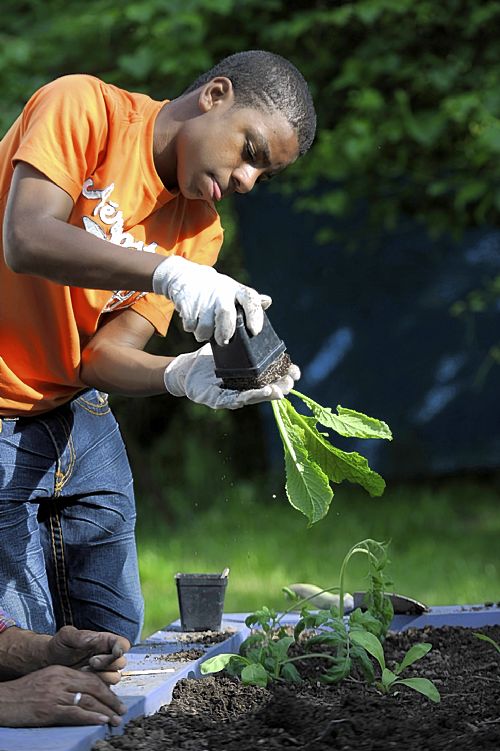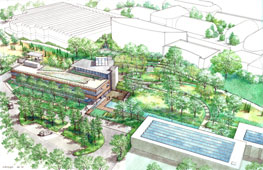
Category Archive: Landscapes
-
Cities, Including Pittsburgh, Are Turning Green With Urban Farms
Thursday, July 08, 2010By Diana Nelson Jones, Pittsburgh Post-GazetteThe urban farm — a novel, even whimsical, idea a few years ago in Pittsburgh — is now a movement so fully fledged that a neighborhood without one seems almost an anomaly.
Nationally, the movement is profuse, with seeds in the 1980s when foodies sprouted and gourmet eating went mainstream. The roots of several movements have intertwined since: urban enterprise farms, urban farms for educating children, community gardens, vacant lot greening, soil remediation of industrial landscapes, community supported agriculture, backyard chickens and bee hives, consumers who buy into livestock with farmers and grocery chains selling local produce.
Grow Pittsburgh, whose mission is to support urban gardening, is a 5-year-old nonprofit that can’t keep tabs on the number of gardens being planted in the city’s public spaces, said Julie Butcher Pezzino, executive director.
Grow Pittsburgh is a partner of groups operating gardens in Braddock, Lawrenceville, Larimer and Lemington. It is searching for a suitable plot Uptown and has Troy Hill and Hazelwood on schedule for next year.
An online search of terms such as “urban farm,” “sustainable food” and “buy local” shows how robust the movement is in other cities. Interest here has skyrocketed.
Grow Pittsburgh’s latest foray is to widen its scope. It is working with Allegheny County and the Western Pennsylvania Conservancy in a pilot program to encourage gardening partnerships outside the city. It is currently developing projects in Millvale and McKees Rocks.
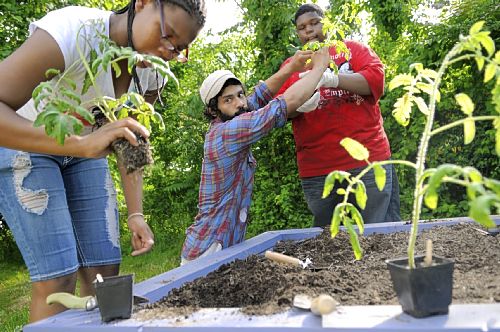
Rebecca Droke/Post-Gazette --- Jayda Harden, 14, left, with Mark Williams, center, and Brandon Kenney, 14, plant tomatoes in a raised bed for the Lots of Hope gardening project at The Pittsburgh Project on the North Side.
It has also collaborated with McAuley Ministries, the granting arm of Pittsburgh Mercy Health System, GTECH Strategies, the Pittsburgh Housing Authority, the A. Randolph Institute and the Greater Pittsburgh Community Food Bank to create the Francis Street Community Garden and Urban Farm Project on approximately 1 1/2 acres at Bedford Avenue and Francis Street in the Hill District.
McAuley Ministries granted $37,580 to the project. Produce from that garden will be sold to the Greater Pittsburgh Community Food Bank for distribution through a farmers market and farm stands located at the Hill House and Addison Terrace.
“In the last two or three years, we have gotten calls upon calls from people asking for help and technical assistance” in starting a community farm, said Ms. Butcher Pezzino. “We are still developing our policies” on partnership standards. “It’s new for us to be helping so many groups.
“One of our goals is to start trying to document and find where all the places are” that have not relied on Grow Pittsburgh’s help. “I’ve gotten calls from people asking if we are partners in gardens that I have never heard of.”
A lot of things happened last year to help the momentum nationally:
The U.S. Department of Agriculture’s “Know Your Farmer, Know Your Food” campaign kicked into gear last summer, giving USDA employees the directive to consider starting their own gardens.
First Lady Michelle Obama planted a kitchen garden at the White House.
The movie “Food Inc.” opened a lot of eyes to the ways and means of corporate food agriculture.
The movement is further bolstered by occasional recalls and reports of tainting.
Among the oldest and most successful urban agriculture projects are the Food Project in Massachusetts, which started in 1992 and has mushroomed to include numerous acres throughout the Boston area, including inner-city Roxbury. It has 25 full-time staff, employs 100 youth and attracts 2,000 volunteers each year. It sells and donates more than 250,000 pounds of food each season. It is also a source of food for community-supported agriculture, or CSA, subscribers.
Will Allen’s Growing Power Inc., founded in 1995 in Milwaukee, was recently hailed at the Women’s Health & the Environment Conference in Pittsburgh. Growing Power has become a national advocate that trains and offers technical support to communities in growing food and selling it.
Urban Farming, a Detroit nonprofit, grew from a pilot of three gardens in 2005 to 600 gardens across the country today. Its mission is to take over vacant space, grow food and give it away to people who live nearby.
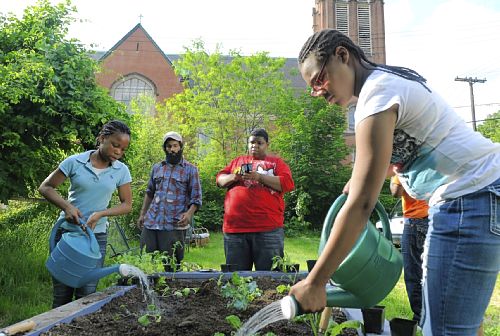
Rebecca Droke/Post-Gazette --- Ceasia Williams, 14, left, and Jayda Harden, 14, water newly planted seedlings in a raised bed for the Lots of Hope gardening project at The Pittsburgh Project on the North Side.
Braddock Farms was not the area’s first big garden on public land when Grow Pittsburgh established it in 2007, but it set a standard for what “urban farm” means locally. On three-quarters of an acre, it may be the largest nonprofit farm in Allegheny County and is the leading “enterprise” farm. A dozen area restaurants buy produce from it.
“We have developed a market base within the high-end restaurant community for our produce from there,” said Ms. Butcher Pezzino, “but it is not yet sustaining itself.”
The Pittsburgh Project in Perry South has expanded the size and scope of a teaching garden for its summer youth over three years. The Lots of Hope project not only broadens children’s understanding of food and nutrition, it also teaches them how to run a small business — a farm stand — and the value of supplying food to their neighborhood.
“We started the farm as a food access initiative,” said Jonathan Young, an AmeriCorps worker. The neighborhood is hilly and lacks a grocery people can walk to. The Project last year got the city’s permission to farm on an abandoned baseball field near its Charles Street campus. It will expand its Thursday farmers market and deliver what it doesn’t sell to the elderly in nearby high-rises.
The Thursday farmers market season at the Project began June 10; the hours are 2 to 6 p.m.
Last year, Mr. Young said, the farm stand made enough to cover its costs; infusions of food from the Greater Pittsburgh Community Food Bank help during lean growing times.
“My hope this year is that 30 percent of the operating budget is covered by revenues from our farm stand,” he said. The Project has its first commercial buyer of produce — Bistro to Go on East Ohio Street in Deutschtown, which is also sharing its organic waste so the Project can accumulate compost.
“These are exciting times,” said Mr. Young.
Grow Pittsburgh’s sites include the Larimer Farm and Gardens, a quarter acre at Larimer Avenue and Mayflower Street; Lawrenceville Gardens at Allegheny Cemetery, about 150 square feet; and a garden the size of four city lots on Lincoln Avenue in Lemington called Higher Ground Community Garden.
The Larimer site got grant funding so Grow Pittsburgh could hire a part-time manager, said Ms. Butcher Pezzino, “someone who is there 20 hours a week and can keep it looking good. That could be an awesome model.”
Larimer’s site is a community garden and a farming effort of the Larimer Green Team.
“They’re calling it a farming garden” with hopes of becoming vendors, “but the market is still being tested” as to how much an enterprise garden can make above its expenses, she said.
Interest from residents who want plots shot up from seven requests last year to 20 this year, she said.
Ebony Earth started the Higher Ground garden with Grow Pittsburgh’s help in 2007 as a green hobby, she said. “The whole point was to get the community living a healthier lifestyle.” She has been giving the produce to neighbors but said she might look for a commercial outlet and offer plots for neighbors to grow their own food. She and the other volunteers who garden the lots have been supported by the Greater Pittsburgh Community Food Bank’s farm-stand program, which offers help, supplies and produce when the farm stand is low on inventory.
All of these gardening projects focus on making fresh local produce affordable to the people who have the least access to it.
“Whole Foods could be in this neighborhood and it wouldn’t matter,” said Mr. Young. “If it’s not an effort like ours, our neighbors can’t afford to eat well.”
-
YWCA’s New Green Roof Contributes to Revitalization of the Wood Street Corridor
Wednesday, June 23, 2010
The 42-year-old YWCA building at 305 Wood Street received a $175,000 grant from the Richard King Mellon Foundation and Eden Hall Foundation to build a new green roof.
The new retro-fitted roof will protect the building envelope from moisture penetration, with a final layer of plantscaping, and is scheduled to be completed by late Fall of this year. Benefits of the new roof will include a longer material lifespan, energy savings, sound insulation, and improved aesthetic appeal and air quality for the neighborhood.
The roof, which the YWCA hopes will contribute to securing LEED certification, will be a landmark for the green revitalization of the Wood Street corridor, and it’s coming at a great time. Point Park University‘s new $244 million state of the art Academic Village is under construction nearby.
“In the spirit of being a good neighbor as Point Park undertakes this effort, we would like to restore and aesthetically enhance our facility to become a part of this transformation, as well as create a more environmentally friendly option that safely houses our programs and services,” says Carmelle Nickens Phillips, Vice President of the YWCA‘s department of Development and Communications.
Following the Richard King Mellon Foundation and Eden Hall grant, several other local foundations stepped up to help provide support for the new roof, including FISA Foundation, The Hillman Foundation, the PNC Foundation, and one anonymous source.
Writer: John Farley
Sources: Carmelle Nickens Phillips, VP of YWCA department of Development and Communications -
North Park Lake Workers Dig in Deep
By Bill Vidonic
PITTSBURGH TRIBUNE-REVIEW
Thursday, June 17, 2010For nearly 80 years, North Park Lake was considered the centerpiece of the Allegheny County park, its serene waters welcoming boaters and anglers.
These days, it’s anything but welcoming, essentially little more than a muddy hole as it undergoes a $16 million transformation.
Within a year, if all goes according to plan, the lake will be deeper, bigger and once again host nature lovers from across the region.
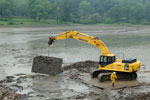
Allison Park Contractors, Inc. work to position swamp pads for installing temporary check dams to slow water in North Park Lake. Once considered the centerpiece of the Allegheny County park, North Park Lake is undergoing a $16 million transformation to reclaim its banks and restore its depth. Jasmine Goldband | Tribune-Review
“We had some little setbacks in the winter, but we’re making some good progress now,” said Craig Carney, project manager for the U.S. Army Corps of Engineers. “We’re still shooting for (finishing) next spring.”
Within the next couple of weeks, workers will begin scooping sediment off the lake bed and into dump trucks. Those trucks will be making 80 to 100 trips a day, Carney said, to an old fly ash dump along Wildwood Road, near the Pie Traynor baseball field.
Carney said motorists, joggers and bicyclists should be aware that the trucks will be in the park.
In all, the corps expects to remove more than 315,000 cubic yards of sediment from the lake.
Stormwater runoff has been dumping sediment into the lake for decades, according to the corps, along with stream bank erosion from portions of Pine Creek and North Fork creek. That shrunk the 75-acre lake to about 60 acres, and cut the depth of the water by more than half in many areas. Some areas of the lake turned into wetlands, and those areas will be protected.
Without the restoration work, Carney said, the lake — albeit in several decades — would degrade entirely into wetlands.
Work to divert North Fork from the upper portion of the lake was completed last week. Pine Creek’s diversion, on the lower portion of the lake, is continuing.
Carney said draining the lake didn’t go as smoothly as first hoped. The lake was drained in September and October, but heavy rains hit in November. Debris that collected at the lake’s gatehouse caused problems in draining the additional water, and that wasn’t fixed until March.
Since then, Carney said, drainage has gone relatively smoothly. Since the beginning of June, nearly 4 inches of rain has fallen. After each storm, workers are able to drain the water within a day or so.
“It’s been a typical spring,” Carney said. “We had a pretty dry late April and early May.”
North Park Lake project: What’s it all about?History: The once-75-acre lake was created in the 1920s. It is located in Hampton, McCandless and Pine.
Project: Sediment had filled the lake, decreasing the lake’s depth and causing problems for boaters and anglers. The lake was drained beginning Sept. 8. Workers will remove at least 315,000 cubic yards of sediment. Once done, the lake will be restored to its original depth of up to 24 feet. North Fork and Pine Creek are being diverted on the northern and southern ends of the lake to drain the lake and allow workers to scoop up the sediment.
Other work: Improvements will be made to help mitigate downstream flooding. Coir logs, composed of coconut fiber, will be laid along the shoreline to prevent further erosion and sediment buildup. Invasive plants are being removed from the lakebed, which will be lined with gravel to encourage fish spawning. In October, 75 percent of North Park Lake fish, including blue gill, crappie, bass, sunfish and catfish, were relocated upstream to Marshall Lake and Deer Lakes Park.
Cost: $16 million. The federal government has contributed $5 million, and the state $400,000. Allegheny County is paying the remainder.
Source: U.S. Army Corps of Engineers
-
Sewickley Tour Offers Glimpse at Early 1900s Garden
By Joanne Braun
SEWICKLEY HERALD
Thursday, June 17, 2010When Janice and Ronald West moved into their Sewickley Heights home 15 years ago, remnants of the past scattered the property.
One such remnant is an old cherub statue perched in the middle of The Gardens of Poplar Hill on the Country Club Road property. It will be included in the Sewickley Civic Garden Council’s garden tour Friday.
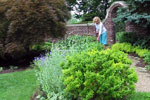
Sewickley Civic Garden Council's garden tour on Friday includes five private gardens within a few blocks of the Edgeworth Club, and a sixth, The Gardens of Poplar Hill in Sewickley Heights, adjacent to Allegheny Country Club. Carolyn Smith, garden tour event coordinator, checks out a few specimens at the Poplar Hill gardens. Joanne Braun | Sewickley Herald
The cherub, which sits in the lower garden, is surrounded by plants, shrubs, brick walls, black iron gates and a roofed summer house, all dating back to the early 1900s. The garden is being cataloged as a historic garden for the Smithsonian Institution in Washington. Village Garden Club’s Garden History and Design committee provided research and documentation — the first time the club, which is a member of the Garden Club of America, has attempted such an undertaking.
Committee members Cathy Snyder, Cordelia Jacobs, Alisa Lenhardt and Lisa Burrows will send their work to the club’s Garden Club of America’s zone coordinator in Philadelphia. Once the research and photos are approved, it will be sent to the Smithsonian for inclusion in the Archives of American Gardens.
Kelly Crawford, museum specialist at the Smithsonian, said the Archives of American Gardens collection captures more than 6,500 American gardens in 80,000 images, historic records, illustrations and plans.
“Some of these records fix a moment in the life of an existing garden, and others describe gardens that are no longer in existence,” she said.
Snyder said Arthur Shurcliff, a member of an architectural firm that became famous for its garden designs, designed the original landscaping at Poplar Hill in 1914.
The property once featured a 35-room carriage house, which later was torn down by a new owner. The property housed numerous families over the years who added structures, sold off some of the land and subdivided it.
In 1948, The Gardens of Poplar Hill were chosen as featured gardens at the Garden Club of America annual meeting. It was part of a tour sponsored by Pittsburgh History and Landmarks Foundation in 1997.
When the Wests moved in, they refurbished much of the deteriorating brickwork, rehung the iron gates, reconstructed and refurbished the limestone windows within the brickwork, and replaced the roof and copper gutters on the summer house.
At that time, most of the flower beds were empty. Poplar trees, for which the property was named, once grew outside the brick walls but were lost to disease in the 1960s.
“There were very little perennials left. We had to start over with the plantings,” Janice West said.
However, large specimen trees, bushes and hedges still flourished throughout the property, and peonies and Japanese iris remained in the lower garden.
As visitors enter the lower garden, they can walk on pathways of blue slate and pea gravel that wind around the inside courtyard. Niches with two Japanese statues, with shallow pools in front of each, face one another across the courtyard.
Also featured are blue spruce and juniper surrounding the side of the house. Dark green boxwood blends with the softer pastel hues of Russian sage and astilbe. Not far away are colored foxgloves and coneflowers mixing with japonica and peonies. Blue geraniums and Japanese grass also make a home in the garden.
“I try to repeat some of the same plants in different spots,” West said.
The couple purchased and placed stone urns to replicate those in photographs from the 1930s atop two brick pillars closer to the house.
Nearby are more large shrubs, which were not there in the original landscape.
“There used to be lillies and flowers along the way. This was just a walkway to the house. I thought about taking the bushes out, but they are so mature,” West said.
As visitors continue to the back of the house, they will get a view of the Allegheny Country Club’s fairways and clubhouse.
That side of the house features an added greenhouse and a large birdbath along with a horseshoe hedge of yews believed to be part of the original landscape. The Wests added more mature yews to the hedges to complete the horseshoe shape, which now surrounds the original English wellhead and two large swamp cypresses. Janice West planted a vegetable garden on the eastern side of the house in the rear, near to where other such gardens originally grew. Plants are held up by trellises of different colors.
In a document prepared for the Smithsonian, committee members wrote, “Without question, Poplar Hill remains a significant treasure in garden design. The fact that it is in the hands of genuine enthusiasts who understand and appreciate the importance of documenting its evolution, preserving its integrity and sharing its beauty with others bodes well for the future.”
If you go
What: Sewickley Civic Garden Council’s garden tour, including five private gardens within a few blocks of the Edgeworth Club. The sixth, The Gardens of Poplar Hill in Sewickley Heights, is adjacent to Allegheny Country Club.
When: 9 a.m. to 4 p.m. Friday. Jan Godshalk, award-winning floral designer, will present a floral arranging demonstration at a luncheon at the Edgeworth Club from noon to 1:30 p.m.
Cost: $20, or $35 for the demonstration. Lunch not included. A combination ticket for the tour and lecture is $50. Tickets are available in Sewickley at Cuttings, Walnut Street; The Gift Corner, Broad Street; and Penguin Book Store, Spoiled Chics and Cheers, Beaver Street.
For more information: Visit www.sewickleygardens.org.
-
Foundations Aid Pittsburgh YWCA’s Green Roof
By Bill Zlatos
PITTSBURGH TRIBUNE-REVIEW
Thursday, June 17, 2010The YWCA is getting a green roof, part of a campaign by charitable foundations to make Downtown more environmentally friendly.
“We’ve seen an increasing number of green roofs in Pittsburgh in the past three years, some of which are Downtown,” said Aurora Sharrard, director of innovation for the Pittsburgh Green Building Alliance.
When its roof is completed, the YWCA will join the Highmark Building, Fifth Avenue Place and the Heinz 57 Center among Downtown buildings with green roofs, she said. The Allegheny County Office Building also is installing one.
Green roofs use plants to soak up rain and reduce runoff, cut heating and air conditioning costs, make the building quieter and improve air quality.
Reducing runoff is especially important in Allegheny County because storm and sewage overflow is released into the rivers during hard rains.
“We want an environmentally responsible green roof,” said Carmelle Nickens Phillips, the YWCA’s vice president of development and communications. “It provides a lot of benefits — a longer material lifespan, energy savings, sound insulation, and it’s really compatible with the neighborhood.”
Phillips cited neighboring Point Park University’s $244 million Academic Village. The university’s plan includes street improvements and tree plantings on Boulevard of the Allies at the end of July and converting the old YMCA building on the boulevard into a Student and Convocation Center. The university completed a dance studio that has a gold certification in Leadership in Energy and Environmental Design, or LEED, from the U.S. Green Building Council.
“We’re very excited about continuing our part of neighborhood enhancements that are green-based and are pleased to know that other neighbors are doing so as well,” said Point Park spokeswoman Mary Ellen Solomon.
The cost of the YWCA roof is $1.1 million. Its building on Wood Street is 42 years old.
The Richard King Mellon Foundation gave the YWCA $125,000 and the Eden Hall Foundation gave $50,000 — raising the total amount from foundations to nearly $400,000. The Mellon Foundation agreed to provide a challenge grant within the next 18 months, and the Pennsylvania Redevelopment Assistance Capital Program will provide $500,000.
Scott Izzo, director of the Mellon Foundation, declined comment. Officials with Eden Hall could not be reached.
-
Phipps’ Center for Sustainable Landscapes Chosen to Test New Green Design Rating System
Pop City Media
Wednesday, June 16, 2010
Phipps Conservatory and Botanical Garden’s Center for Sustainable Landscapes, which is in its final phase of design, has been selected to join 175 other pilot programs to test a revolutionary new rating system for green landscape design called The Sustainable Sites Initiative, or SITES.

SITES is similar to the LEED building rating system, only for landscapes, and is set to become the international standard for eco-friendly landscape practices. The Center for Sustainable Landscapes was asked to join the testing program, because of the new building’s impressive list of sustainable features.
The $20 million Center for Sustainable Landscapes, a research and educational institution, will be a Living Building, going far beyond LEED certification, by generating all of its own energy with renewable resources, and capturing all water on site. It features a green roof, rain gardens, permeable paving, locally harvested and salvaged materials, and a wetland and lagoon system. Landscape practices at the building will include protecting and restoring soil conditions, native plant landscaping and ecosystem restoration, and revolutionary energy efficiency.
“The opportunity to combine cutting edge building technology with the highest standards of sustainable landscape design will allow Phipps to present a complete picture of how important it is to sensitively integrate our buildings into the environment and how important plants are to our lives,” says Phipps’ Director Richard Piacentini.
The pilot phase for SITES is scheduled to run through June 2012, and feedback from The Center for Sustainable Landscapes as it nears the end of its design phase and enters construction, will help SITES finalize their rating system by 2013.
Sign up to receive Pop City each week.
Writer: John Farley
Sources: Liz Fetchin, Communications Director for Phipps Conservatory
Richard Piacentini, Director of Phipps ConservatoryImage courtesy Phipps Conservatory and Botanical Gardens
-
Hill District to Rediscover Itself Via ‘Greenprint’
Wednesday, June 16, 2010By Meredith Skrzypczak, Pittsburgh Post-GazetteHill District residents gathered on a street corner Tuesday as a banner hung above with the words “the village, the woods” written around a picture of the neighborhood.
Plans for community projects that will preserve and sustain the natural and built-up landscape of the Hill were unveiled before the crowd.
Some of those Hill District Greenprint projects include creating a new entrance to Cliffside Park on Cliff Street and a public plaza from Centre Avenue to Kirkpatrick and Centre and Heldman; and cleaning and repairing city steps so residents can move about easily within and outside of the neighborhood.
Terri Baltimore, vice president of neighborhood development for the Hill House Association, said residents of the Hill District should be “rejoicing.”
“A lot of us that live and work in the Hill know the beauty of the neighborhood.”
Phyllis Jackson, 53, has lived on the Hill most of her life and said the projects will bring a new sense of pride to the community.
“We’re trying to put value back in the land,” said Walter Hood, principal of Hood Design and lead consultant for the Hill District Greenprint initiative.
Mr. Wood, who called the Hill one of the greenest pieces of landscape in Pittsburgh, is working with the existing landscape and developing projects that will sustain and transform it.
A Hill District resident for most of her life, Renee Pritchett, 60, said it helps to see the plans. And while there is still work to be done, she said she’s excited that residents can finally start looking ahead with hope for the community.
“Because of outside (negative) influences, it was hard to capture the hope that this brings,” she said. “That has been negated now.”
The project offers an environmentally friendly agenda that will also spark development, said Denys Candy, community development consultant and co-founder of Find the Rivers!, a group that works to develop green spaces in the neighborhood. Most of the projects will hopefully begin within months, he said.
Ms. Jackson said the projects are long overdue, but is happy efforts are finally getting under way.
“We’re doing something today.”
-
Brookline School’s Garden Nurtures Students’ Senses
By Jodi Weigand
PITTSBURGH TRIBUNE-REVIEW
Wednesday, June 16, 2010
Jimi Hutchin, 14, sings "God Bless America" with help from Pioneer chorus director Mark Kwolek during a tree-planting ceremony for the Brookline school's sensory garden on Tuesday. Sidney Davis | Tribune-Review
Pioneer school in Brookline on Tuesday formally dedicated one of the area’s first sensory gardens located at a public school.
The gardens provide people with intellectual and developmental disabilities a range of sounds, sights, textures and smells. Pioneer serves about 75 children and adults ages 5 to 21 with rare disabilities and special medical needs.
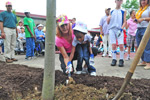
Pioneer school special-education teacher Mary Lou Walczak helps Cache Brown, 8, plant a tree for the school's sensory garden on Tuesday. Sidney Davis | Tribune-Review
“What an important prototype this is going to become for our entire region,” said Judy Wagner, senior director of the community garden and green space program for the Western Pennsylvania Conservancy, which helped design the garden. “This is a very special example of how greenery can really improve the lives of everyone.”
Pioneer’s garden, on about an acre of land in the school’s backyard, has textured plants and brightly colored, fragrant blooms. It features a fountain, hummingbird feeders, swings and benches. Still to be installed are vine canopies over some of the walkways, outdoor musical instruments and raised planters for students to use. A $100,000 grant from the Edith L. Tress Charitable Trust funded the gardens.
“Students will be able to grow fruits and vegetables, and we’ll harvest those for (a course called) activities of daily living, where they learn how to cook and shop and store food,” said Principal Sylbia Kunst. “Our teachers will develop lessons using different parts of the sensory garden.”
Chris Hutchin of Carrick said she’s glad her son Jimi, 14, who has attended the school since 2000, will get to spend more time outdoors.
“A big part of the kids’ growth is being outside,” she said.
When designing the garden, Pioneer officials and the architect sought input from organizations such as the Western Pennsylvania School for Blind Children and Allegheny Valley School, which both have sensory gardens.
“They can encourage imagination or stress release (or) if someone needs to have more stimulation because they’re lethargic,” said Carol Erzen, director of training and staff development at Allegheny Valley School, which provides therapeutic programs to adults and children with disabilities. “It’s a place to truly enjoy nature.”
Kunst said having a secure, handicapped accessible garden at Pioneer will provide more learning opportunities.
“This is another way for our kids to be involved,” she said.

